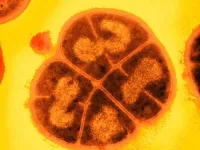(Press-News.org) Burlington, Vt.— A team of UVM scientists led by Mark Nelson, Ph.D., from the Larner College of Medicine at the University of Vermont, has uncovered a novel mechanism that reshapes our understanding of how blood flow is regulated in the brain. The study, published in The Proceedings of the National Academy of Sciences (PNAS), a peer reviewed journal of the National Academy of Sciences (NAS), introduces Electro-Calcium (E-Ca) Coupling, a process that integrates electrical and calcium signaling in brain capillaries to ensure precise blood flow delivery to active neurons.
In the human body, blood is delivered into the brain from surface arteries through penetrating arterioles, or very small blood vessel that branch off from arteries, and hundreds of miles of capillaries, which enormously extend the territory of perfusion. The brain—a highly metabolically demanding organ that lacks substantial energy reserves—maintains constant blood flow in the face of blood pressure fluctuations (autoregulation) but relies on an on-demand delivery process in which neuronal activity triggers a local increase in blood flow to selectively distribute oxygen and nutrients to active regions.
“This use-dependent increase in local blood flow (functional hyperemia), mediated by mechanisms collectively termed neurovascular coupling (NVC), is essential for normal brain function and represents the physiological basis for functional magnetic resonance imaging,” said Nelson. “Furthermore, deficits in cerebral blood flow (CBF) including functional hyperemia are an early feature of small vessel diseases (SVDs) of the brain and Alzheimer’s long before overt clinical symptoms.”
Cerebral blood delivery depends on mechanisms such as electrical signaling, which propagates through capillary networks to upstream arterioles to deliver blood, and calcium signaling, which fine-tunes local blood flow. For years, these mechanisms were thought to operate independently. However, Nelson’s research reveals that these systems are deeply interconnected through E-Ca coupling, where electrical signals enhance calcium entry into cells, amplifying localized signals and extending their influence to neighboring cells.
The study demonstrated that electrical hyperpolarization in capillary cells spreads rapidly through activation of capillary endothelial Kir2.1 channels, specialized proteins in the cell membrane that detect changes in potassium levels and amplify electrical signals by passing them from cell to cell. This creates a wave-like electrical signal that travels across the capillary network. At the same time, calcium signals, initiated by IP3 receptors—proteins located in the membranes of intracellular storage sites—release stored calcium in response to specific chemical signals. This local release of calcium fine-tunes blood flow by triggering vascular responses. E-Ca coupling bridges these two processes, with the electrical waves generated by Kir2.1 channels enhancing calcium activity, creating a synchronized system that adjusts blood flow both locally and across wider distances.
Using advanced imaging and computer models, the researchers were able to observe this mechanism in action. They found that electrical signals in capillary cells boosted calcium activity by 76%, significantly increasing its ability to influence blood flow. When the team mimicked brain activity by stimulating these cells, calcium signals increased by 35%, showing how these signals travel through the capillary network. Interestingly, they discovered that the signals spread evenly throughout the capillary bed, ensuring that blood flow is balanced across all areas, without favoring one direction or another.
“Recently, the UVM team also demonstrated that deficits in cerebral blood flow in small vessel disease of the brain and Alzheimer’s could be corrected by an essential co-factor of electrical signaling,” noted Nelson. “The current work indicates that calcium signaling could also be restored. The ‘Holy Grail,’ so to speak, is whether early restoration of cerebral blood flow in brain blood vessel disease slows cognitive decline.”
This discovery underscores the vital role of capillaries in managing blood flow within the brain. By identifying how electrical and calcium signals work together through electro-calcium coupling, the research sheds light on the brain's ability to efficiently direct blood to areas with the greatest demand for oxygen and nutrients. This is especially significant because disruptions in blood flow are a hallmark of many neurological conditions, such as stroke, dementia, and Alzheimer's disease. Understanding the mechanics of E-Ca coupling offers a new framework for exploring treatments for these conditions, potentially leading to therapies that restore or enhance blood flow and protect brain health. This breakthrough also provides a deeper understanding of how the brain maintains its energy balance, which is critical for sustaining cognitive and physical function.
The research discussed in this publication was supported by the National Institute on Aging (NIA) and the National Institute of Neurological Disorders and Stroke (NINDS) under grants K99-AG-075175 (A.M.), R01-NS-110656 (M.T.N.), RF1-NS-128963-01 (M.T.N.), and R01-NS-119971 (N.M.T.). Additional funding was provided by the National Institute of General Medical Sciences (NIGMS) through grant P20-GM-135007 (M.T.N. & Mary Cushman), the National Heart, Lung, and Blood Institute (NHLBI) through grant R35-HL-140027 (M.T.N.), and the American Heart Association through a Career Development Award (856791 to A.M.) and a postdoctoral fellowship (20POST35210155 to A.M.). Support was also received from the Totman Medical Research Trust (M.T.N.), the European Union Horizon 2020 Research and Innovation Programme (Grant Agreement 666881, SVDs@target, M.T.N.), and the Leducq Foundation Transatlantic Network of Excellence (International Network of Excellence on Brain Endothelium: A Nexus for Cerebral Small Vessel Disease, M.T.N.).
####
About the Larner College of Medicine at the University of Vermont
Founded in 1822, the Robert Larner, M.D., College of Medicine at the University of Vermont is dedicated to developing exceptional physicians and scientists by offering innovative curriculum designs, state-of-the-art research facilities, and clinical partnerships with leading health care institutions. The college’s commitment to excellence has earned national recognition, attracting talented students, trainees, physicians, and researchers from across the country. With a focus on inclusive excellence, the Larner College of Medicine prides itself on cultivating an environment that uplifts and supports its faculty and student populations while advancing medical education, research, and patient care in Vermont and beyond.
Learn more at uvm.edu/larnermed
END
Dubbed “Conan the Bacterium” for its extraordinary ability to tolerate the harshest of conditions, Deinococcus radiodurans can withstand radiation doses thousands of times higher than what would kill a human — and every other organism for that matter.
The secret behind this impressive resistance is the presence of a collection of simple metabolites, which combine with manganese to form a powerful antioxidant. Now, chemists at Northwestern University and the Uniformed Services University (USU) have discovered how this antioxidant works.
In ...
A new USC Stem Cell study published in the Proceedings of the National Academy of Sciences (PNAS) has identified key gene regulators that enable some deafened animals—including fish and lizards—to naturally regenerate their hearing. The findings could guide future efforts to stimulate the regeneration of sensory hearing cells in patients with hearing loss and balance disorders.
Led by first author Tuo Shi and co-corresponding authors Ksenia Gnedeva and Gage Crump at the Keck School of Medicine of USC, the study focuses on two cell types in the inner ear: the sensory cells that detect sound, and the supporting cells that create an environment where ...
CLEVELAND (Dec. 9)—A cave in Galilee, Israel, has yielded evidence for ritualistic gathering 35,000 years ago, the earliest on the Asian continent. Three Israeli researchers led the team that published its results today in the journal Proceedings of the National Academy of Sciences.
And researchers from the Case Western Reserve University (CWRU) School of Dental Medicine helped unearth the cave’s secrets over more than a decade of excavation.
Manot Cave was used for thousands of years as a living space for both Neanderthals ...
A collaborative study has uncovered evidence of rice beer dating back approximately 10,000 years at the Shangshan site in Zhejiang Province, China, providing new insights into the origins of alcoholic beverage brewing in East Asia.
This discovery highlights the connection between rice fermentation at Shangshan and the region’s cultural and environmental context as well as the broader development of early rice agriculture and social structures.
The study was jointly conducted by researchers from Stanford University, the Institute of Geology and Geophysics (IGG) of the Chinese Academy of Sciences, and the Zhejiang Provincial Institute ...
December 9, 2024 (Washington, DC, United States of America and Amsterdam, the Netherlands) - The Society for Research in Child Development (SRCD) and the International Society for the Study of Behavioural Development (ISSBD) were recently awarded 200,000 Swiss Francs from the Jacobs Foundation to support initiatives related to mentoring early career scholars from Ghana and Colombia in the areas of grant writing, research methodology, peer reviewing, and scholarly publishing. The grants are part of a larger collaborative project called the ...
LA JOLLA, CA—Imagine an artificial intelligence (AI) model that can watch and understand moving images with the subtlety of a human brain. Now, scientists at Scripps Research have made this a reality by creating MovieNet: an innovative AI that processes videos much like how our brains interpret real-life scenes as they unfold over time.
This brain-inspired AI model, detailed in a study published in the Proceedings of the National Academy of Sciences on November 19, 2024, can perceive moving scenes by simulating how neurons—or brain cells—make real-time sense of the world. Conventional ...
More than half of laws and policies on healthcare workers’ rights align with international standards, according to a study published December 9, 2024 in the open-access journal PLOS Global Public Health by Matthew Kavanagh from Georgetown University, U.S., James Campbell from the World Health Organization, Switzerland, and colleagues.
As the COVID-19 pandemic unfolded, healthcare workers were at the forefront to stem the tide, often putting their own health at risk. Inadequate infection control measures and insufficient access to personal protective ...
University of Houston psychology researcher Jason Griffin, who has pioneered new ways of measuring eye movements to understand autism spectrum disorder, is reporting that children with autism focus on faces differently than other children, especially in the early stages of visual processing. His findings may lead to improvement in face processing for those with the neurodevelopmental condition.
For most people, looking eye-to-eye with someone while talking seems an important yet innocuous social convention – one barely thought of during polite conversation. But for those with autism, characterized ...
The majority of the known asteroids orbit within the main asteroid belt located between Mars and Jupiter at an average distance from Earth of about 250 millions kilometers. Since the discovery of the first asteroid in 1801, nearly 750.000 of them have already been numbered, mainly in the last decade thanks to the many optical surveys searching the sky every clear nights. Most of these asteroids are larger than 1 kilometer, the largest one, Vesta, at about 530 km in diameter, while many millions of smaller ones are expected. While these look huge numbers, the total mass of all the asteroids combined is less than that of Earth's Moon.
Sometimes, these asteroids ...
SAN ANTONIO, Dec. 9, 2024 – Mays Cancer Center at The University of Texas Health Science Center at San Antonio (UT Health San Antonio), in partnership with the American Association for Cancer Research (AACR), is hosting the 47th annual San Antonio Breast Cancer Symposium at the Henry B. Gonzalez Convention Center on Dec. 10-13.
Owned and initiated by Mays Cancer Center, the San Antonio Breast Cancer Symposium is the world’s largest breast cancer research conference. More than 11,000 clinicians, researchers, and patient ...










